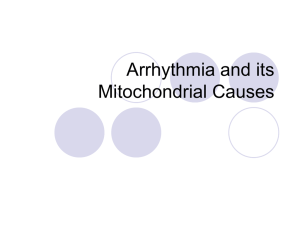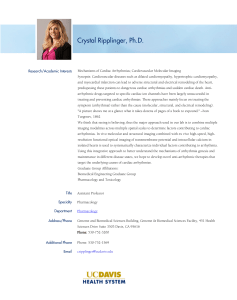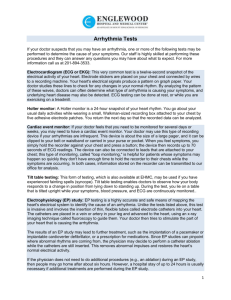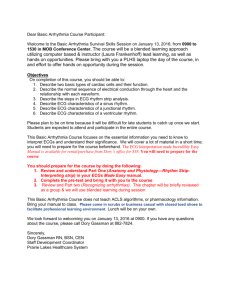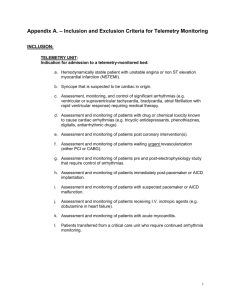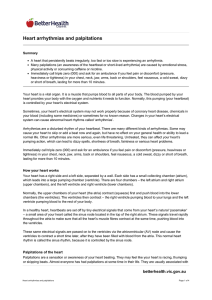What is an Arrhythmia? - American Heart Association
advertisement
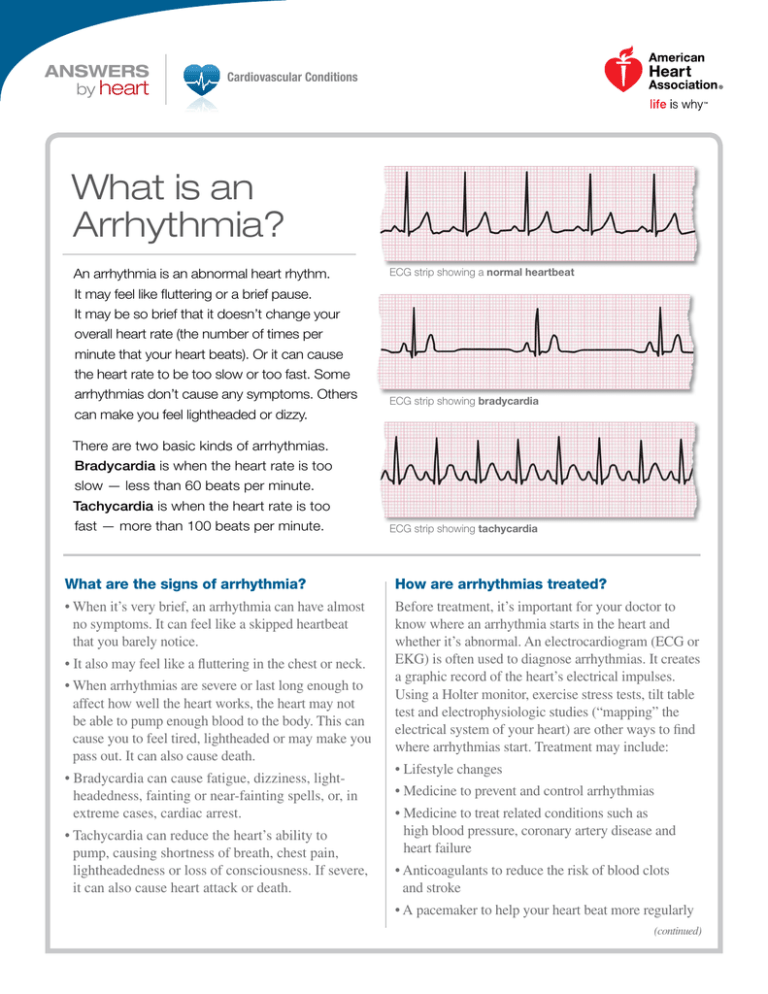
ANSWERS by heart Cardiovascular Conditions What is an Arrhythmia? An arrhythmia is an abnormal heart rhythm. ECG strip showing a normal heartbeat It may feel like fluttering or a brief pause. It may be so brief that it doesn’t change your overall heart rate (the number of times per minute that your heart beats). Or it can cause the heart rate to be too slow or too fast. Some arrhythmias don’t cause any symptoms. Others can make you feel lightheaded or dizzy. ECG strip showing bradycardia There are two basic kinds of arrhythmias. Bradycardia is when the heart rate is too slow — less than 60 beats per minute. Tachycardia is when the heart rate is too fast — more than 100 beats per minute. ECG strip showing tachycardia What are the signs of arrhythmia? How are arrhythmias treated? • When it’s very brief, an arrhythmia can have almost no symptoms. It can feel like a skipped heartbeat that you barely notice. Before treatment, it’s important for your doctor to know where an arrhythmia starts in the heart and whether it’s abnormal. An electrocardiogram (ECG or EKG) is often used to diagnose arrhythmias. It creates a graphic record of the heart’s electrical impulses. Using a Holter monitor, exercise stress tests, tilt table test and electrophysiologic studies (“mapping” the electrical system of your heart) are other ways to find where arrhythmias start. Treatment may include: • It also may feel like a fluttering in the chest or neck. • When arrhythmias are severe or last long enough to affect how well the heart works, the heart may not be able to pump enough blood to the body. This can cause you to feel tired, lightheaded or may make you pass out. It can also cause death. • Bradycardia can cause fatigue, dizziness, lightheadedness, fainting or near-fainting spells, or, in extreme cases, cardiac arrest. • Tachycardia can reduce the heart’s ability to pump, causing shortness of breath, chest pain, lightheadedness or loss of consciousness. If severe, it can also cause heart attack or death. • Lifestyle changes • Medicine to prevent and control arrhythmias • Medicine to treat related conditions such as high blood pressure, coronary artery disease and heart failure • Anticoagulants to reduce the risk of blood clots and stroke • A pacemaker to help your heart beat more regularly (continued) ANSWERS by heart Cardiovascular Conditions What is an Arrhythmia? • Cardiac defibrillation and implanted cardioverter defibrillators (ICDs) • Cardiac ablation • Surgery What is defibrillation? It’s a way of returning an abnormal heartbeat to normal with a very brief electric shock. • An implantable cardioverter defibrillator (ICD) may be placed under the skin of the upper chest to give shocks and/or work as a pacemaker. It knows when the heartbeat isn’t normal and works 24 hours a day. What is ablation? It’s a way to fix an arrhythmia and get your heart to beat normally. An ICD is implanted under the skin, just under the collarbone. It detects arrhythmias and responds with electrical signals to restore your heart's normal rhythm. • It’s done by putting a thin tube (catheter) in your vein and guiding it to the heart muscle. The tip of the catheter delivers a burst of energy that destroys the very small areas of heart tissue that are causing the abnormal electrical signals. HOW CAN I LEARN MORE? Call 1-800-AHA-USA1 (1-800-242-8721), or visit heart.org to learn more about heart disease and stroke. Sign up to get Heart Insight, a free magazine for heart patients and their families, at heartinsight.org. Connect with others sharing similar journeys with heart disease and stroke by joining our Support Network at heart.org/supportnetwork. Do you have questions for the doctor or nurse? My Quest ion s: Take a few minutes to write your questions for the next time you see your healthcare provider. For example: Can my arrhythmia be cured? Will I have to keep taking medicine? We have many other fact sheets to help you make healthier choices to reduce your risk, manage disease or care for a loved one. Visit heart.org/answersbyheart to learn more. ©2015, American Heart Association

